

Quick Tip: Photographing Snow. ... even when the camera ‘accurately’ determines the correct exposure using the metering mode of your preference, with a subject like snow you are likely to see underexposed results...
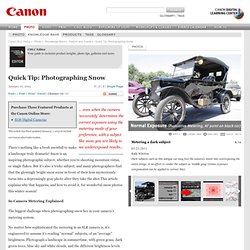
This article has been updated January 7, 2013 to include current product information. There’s nothing like a fresh snowfall to make a landscape truly dramatic! Snow is an inspiring photographic subject, whether you’re shooting mountain vistas, or single flakes. But it’s also a tricky subject, and many photographers find that the glowingly bright snow scene in front of their lens mysteriously turns into a depressingly gray photo after they take the shot.This article explains why that happens, and how to avoid it, for wonderful snow photos this winter season! In-Camera Metering Explained. Exposing Snow. Come winter, nothing frustrates photographers more than poor exposures due to extensive amounts of snow in the scene.
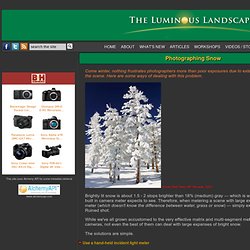
Here are some ways of dealing with this problem. Snow Clad Tress ‹ Nevada, 2001 Brightly lit snow is about 1.5 - 2 stops brighter than 18% (medium) gray — which is what your hand-held or built in camera meter expects to see. Therefore, when metering a scene with large expanses of snow the meter (which doesn't know the difference between water, grass or snow) — simply exposes it as medium gray. Ruined shot. While we've all grown accustomed to the very effective matrix and multi-segment metering in contemporary cameras, not even the best of them can deal with large expanses of bright snow.
The solutions are simple. The translucent round ball reads the light falling upon it as if it were an 18% (average) gray subject. If you set your meter's or camera's film speed dial to a 1.5 - 2 stop lower setting the camera will expose properly. Sand-Moon-Bush ‹ White Sands. The Snowscape – Creative Tips for Photographing Snow. The Snowscape – Creative Tips for Photographing Snow By: Christopher O'Donnell A snow-covered scene is a favored subject for most photographers, not just those who focus on the landscape.
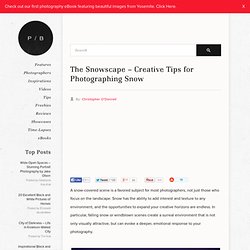
Snow has the ability to add interest and texture to any environment, and the opportunities to expand your creative horizons are endless. In particular, falling snow or windblown scenes create a surreal environment that is not only visually attractive, but can evoke a deeper, emotional response to your photography. Black and white photographers are particularly fond of snow, as it expands the tonal range and contrast to a landscape that lacks any variation until the spring bloom.
Photographing Snow: the simple way to nail exposure. Photographing snow brings a new challenge for many photographers, who struggle to take control of their camera’s metering system amid the winter landscape’s extreme contrast and reflective surfaces.
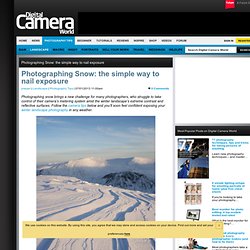
Follow the camera tips below and you’ll soon feel confident exposing your winter landscape photography in any weather. Modern digital cameras are equipped with very accurate exposure meters, but they still have to be used properly to get well-exposed pictures. Your camera’s meter works by measuring reflected light and then calculating what the best exposure should be. The problem when photographing snow is that the light reflected from a light subject is very different from that reflected from a dark subject, and this can cause the camera’s meter to get the exposure wrong.
Our first shot. Winter Wonderland – The Keys to Photographing Snow. By Jason Row on in Shooting Love it or hate, for those of us inhabiting the northern climes, winter is fast approaching. Some of us will pack away our cameras over the long winter months and concentrate on catching up with the editing but some of us will brave the elements and embrace the snow and ice.
Photographing snow has, and still is a difficult task. Even the very best cameras will struggle with exposure and focusing. In this article we will look at some hints and tips to get great winter shots. Be Prepared Cold weather is going to sap your battery power dramatically. Be prepared Johan Lange, on Flickr. How to Photograph Snow. The following two tabs change content below.
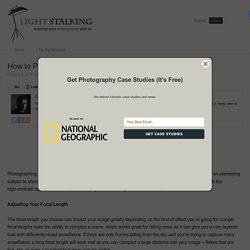
I'm a professional landscape photographer living on the coast of Maine. Through my work, I like to show a vantage point that is rarely seen in reality; a show of beauty, emotion, and serenity. Feel free to visit my website. Photographing snow has its own set of unique rules. The reflective ability of the individual flakes make it an interesting subject to shoot – not to mention all the fun things you can do with your shutter speed. Adjusting Your Focal Length The focal length you choose can impact your image greatly depending on the kind of effect you’re going for. Photo by Christopher O’Donnell This image was taken at f/4 with a focal length of 300mm. Alternatively, a very wide focal length will exaggerate your distances, which is great when you want to encapsulate more of your surroundings. Photo by margolove Aperture Of course, aperture has a role to play here as well.
Photo by **Aina** Photo by Caro Wallis Photo by aurelio.asiain Shutter Speed. How to Shoot Photographs in the Snow. Successful photography in the snow, people skiing for instance, is largely a question of applying the correct exposure compensation.
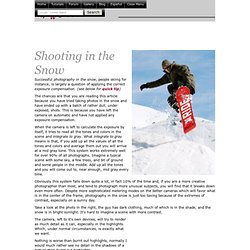
(see below for quick tip) The chances are that you are reading this article because you have tried taking photos in the snow and have ended up with a batch of rather dull, under exposed, shots. This is because you have left the camera on automatic and have not applied any exposure compensation. When the camera is left to calculate the exposure by itself, it tries to read all the tones and colors in the scene and integrate to gray. What integrate to gray means is that, if you add up all the values of all the tones and colors and average them out you will arrive at a mid gray tone. Obviously this system falls down quite a lot, in fact 10% of the time and, if you are a more creative photographer than most, and tend to photograph more unusual subjects, you will find that it breaks down even more often. Exposure Compensation Dial RAW format Histogram White Balance.
Tips on shooting snow and ice. Winter brings a new range of photo opportunities where familiar colourful scenes are suddenly covered in a blanket of snow.
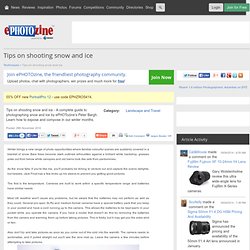
Bare trees become stark outlined silhouettes against a brilliant white backdrop, grasses poke out from below white canopies and old barns look like sets from pantomimes. As the snow falls, if you're like me, you'll probably be itching to venture out and capture the scenic delights, but beware, Jack Frost has a few tricks up his sleeve to prevent you getting good pictures. The first is the temperature. Cameras are built to work within a specific temperature range and batteries have similar needs. Most UK weather won't cause any problems, but be aware that the batteries may not perform as well as they could.
Also don't try and take pictures as soon as you come out of the cold into the warmth. Snow Photography Tips - Improve Winter Photography With Snow Photography Tips. Depending on where you live, the opportunity for winter photography will be an everyday occurrence during the winter months, one of those opportunities you only have on a skiing vacation, or something in between.

If you do happen to live in a location where you're guaranteed a lot of snow each winter, you can shoot great winter photographs with your DSLR camera by just following a few simple tips. Read on for my guide on how to get perfect snow photos! Snow Photography Preparation Tips Photographing objects in snow has a lot of challenges, some of which you cannot prepare for ahead of time. After all, winter weather can be extremely unpredictable. The warm golden light at dawn, combined with the cold blue tones of snow, give magical effects.
Use the Correct Exposures Your camera will want to make everything mid-toned, and this can lead to problems when shooting snow. First, frame your shot and focus.